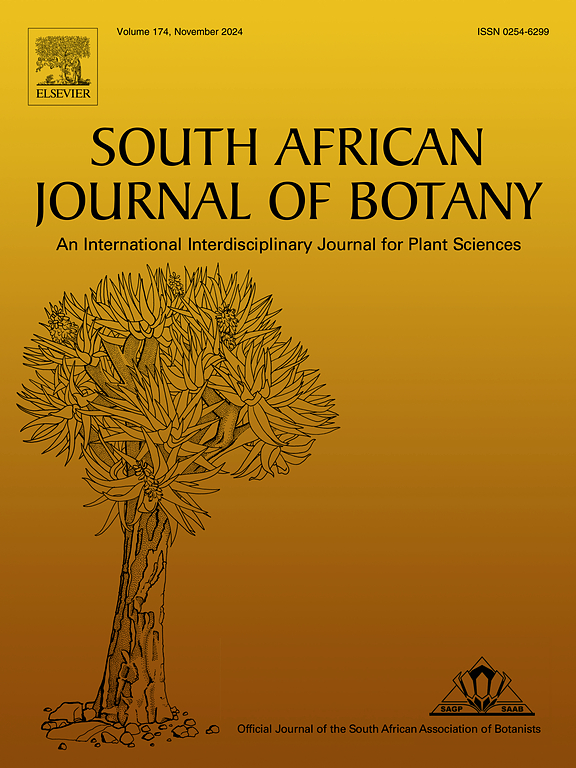Cytotoxic and anti-migration effects of cardiac glycosides from Gomphocarpus fruticosus and Kanahia laniflora on hepatocellular carcinoma; LC-MS/MS profiling, in vitro bioassay and molecular docking study
IF 2.7
3区 生物学
Q2 PLANT SCIENCES
引用次数: 0
Abstract
Hepatocellular carcinoma (HCC) is one of the most aggressive tumors, having a high incidence and mortality rate globally. This study investigated the anticancer effects of Gomphocarpus fruticosus (L.) Ait and Kanahia laniflora (Forsk.) Schum. against HCC using HepG2 cells in vitro. Apoptosis and cell cycle analysis were assessed by flow cytometry to investigate the possible mechanism of action. In addition, antimigratory activity was evaluated by scratch/wound healing assay. G. fruticosus and K. laniflora. significantly (P < 0.05) suppressed the growth of HepG2, with IC50 values of 0.07 µg/ml and 0.77 µg/ml, respectively. In addition, both plants induced S- and G2/M phases arrest while promoting apoptosis. Besides, they markedly reduced the migration of HepG2 cells. LC-MS/MS study revealed the tentative identification of sixty-six and twenty-three chemical compounds in G. fruticosus and K. laniflora, respectively, including diverse classes of phytochemicals. Ten of these compounds were found in both species. A docking study was carried out to investigate the binding potency and mechanism of cardenolides in both plants to Na+, K+-ATPase pump as a target for apoptosis in cancer cells. Generally, compared to common cardenolides, the dioxane doubly linked cardenolide glycosides have more potent inhibition on Na+,K+-ATPase. Finally, the compounds, hydroxyfrugoside (20), 3′-Epi-19-oxo-5,6-didehydrogomphoside-3′O-glucopyranoside (23), hydroxycalotropin (25), frugoside (30) and 3,14-Dihydroxycard-20(22)-ene-3-O-[(6-O-feruloyl)-glucopyranoside] (33) revealed the most potent binding affinity to this target. This study proposed the use of G. fruticosus and K. laniflora for the isolation and development of anticancer medications.
金菖蒲和金菖蒲心苷对肝癌的细胞毒和抗迁移作用LC-MS/MS分析、体外生物测定及分子对接研究
肝细胞癌(HCC)是最具侵袭性的肿瘤之一,在全球范围内具有很高的发病率和死亡率。本研究探讨了贡果(Gomphocarpus fruticosus, L.)的抗癌作用。艾特和金缕兰(Forsk.)Schum。使用HepG2细胞体外抗HCC。通过流式细胞术观察细胞凋亡和细胞周期分析,探讨其可能的作用机制。此外,通过抓痕/伤口愈合试验评估抗迁移活性。金银花和金银花。P <;0.05)抑制HepG2的生长,IC50值分别为0.07µg/ml和0.77µg/ml。此外,两种植物均诱导S-期和G2/M期阻滞,同时促进细胞凋亡。此外,它们还能显著降低HepG2细胞的迁移能力。LC-MS/MS分析初步鉴定出果香和木香中分别含有66种和23种化合物,包括不同种类的植物化学物质。其中10种化合物在两种物种中都被发现。对接研究了两种植物中香芋内酯与Na+, K+- atp酶泵作为癌细胞凋亡靶点的结合能力和机制。一般来说,与普通的香梨苷相比,二氧六环双键香梨苷对Na+,K+- atp酶具有更强的抑制作用。最后,化合物hydroxyfrugoside (20), 3 ' - epi -19-oxo-5,6-didehydrogomphoside-3 ' -o -glucopyranoside (23), hydroxycalotropin (25), frugoside(30)和3,14- dihydroxycard -20(22)-烯-3- o- [(6- o-阿魏酰)-glucopyranoside](33)显示出与该靶点最有效的结合亲和力。本研究提出利用金银花和金银花进行抗癌药物的分离和开发。
本文章由计算机程序翻译,如有差异,请以英文原文为准。
求助全文
约1分钟内获得全文
求助全文
来源期刊

South African Journal of Botany
生物-植物科学
CiteScore
5.20
自引率
9.70%
发文量
709
审稿时长
61 days
期刊介绍:
The South African Journal of Botany publishes original papers that deal with the classification, biodiversity, morphology, physiology, molecular biology, ecology, biotechnology, ethnobotany and other botanically related aspects of species that are of importance to southern Africa. Manuscripts dealing with significant new findings on other species of the world and general botanical principles will also be considered and are encouraged.
 求助内容:
求助内容: 应助结果提醒方式:
应助结果提醒方式:


